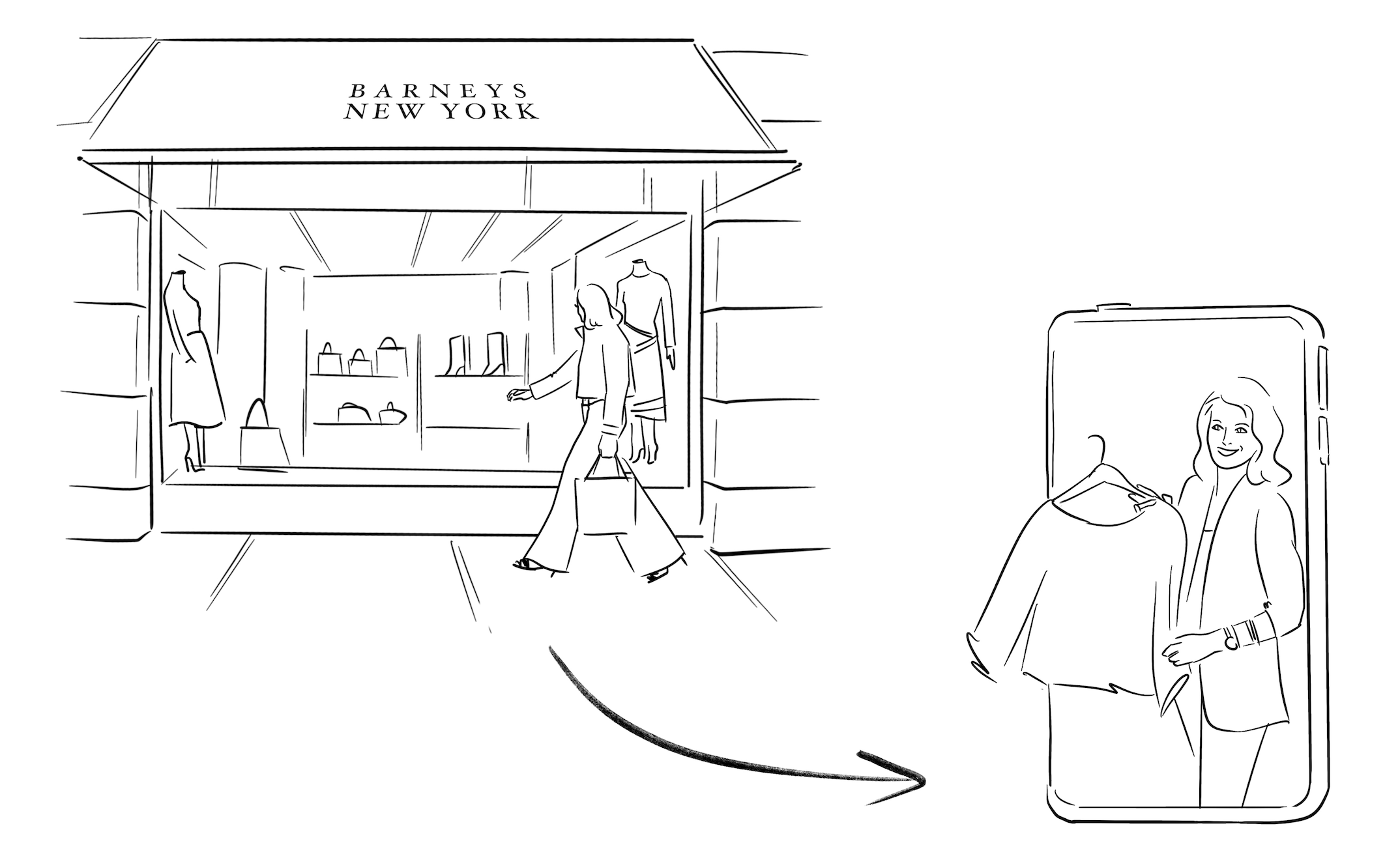As Multi-brand Luxury Retail Stumbles, Will Personal Shoppers Inspire a Solution?
Julie Thibault

Everyone blamed the demise of department stores on the rise of e-commerce. Even in luxury, the feeling just a few short years ago was that online sellers like Farfetch, My Theresa, Net-a-Porter, the RealReal and others were poised to become the next retail juggernauts. But as these business models falter, it seems the luxury industry is exploding into a million fragmented possibilities.
When Buyers and Editors Ruled the (Fashion) World
When Barney’s closed its flagship location in 2019, fashionistas around the world went into mourning. Barney’s merchants were renowned for finding the hottest new brands from beauty to menswear. For a young designer, being picked up by Barney’s and then mentioned in Vogue was the ticket to the big leagues. Barney’s sat with a small group of flagship department stores that were known for their careful curation and their ability to predict trends before they became mainstream. Others in this rarified space included Neiman Marcus and Stanley Korshak in Dallas, Maxfield’s and Fred Segal in LA as well as Bergdorf Goodman, Saks Fifth Avenue and Jeffrey’s in NYC. Each store was masterful at knowing its core customer with some catering to a hipper more fashion-forward crowd, while others serving up looks for the well-heeled local socialite.
Before the prevalence of e-commerce and social media, there were a handful of industry elites that dictated fashion trends. They were department store buyers and magazine editors. Sitting front-and-center at fashion shows in Milan, Paris, and New York, they sifted through runway looks and market week samples to decide what they would feature in their glossy pages or stock on their sales floors.
For a luxury consumer, it was straightforward. Subscribe to Vogue, Elle and Bazaar for inspiration and visit your department store of choice when the new season hit. If you wanted the current “it” bag or shoe, chances are that luxury brand was carried by the department store or even had a shop-in-shop with a broad selection of inventory. You got the store credit card and waited for your Sales Associate to call you when there was a reason to come in like triple points or friends-and-family sales.
Then Digital Content and E-Commerce were Poised to Rule the (Fashion) World
When Net-a-Porter was founded in 2000, the concept was way ahead of its time. It was conceived as a digital magazine where the fashion was shoppable. Looking back now when we can click-to-buy from an influencer’s Instagram page, it was indeed trailblazing. As people began to trust the curation of online luxury retailers, which felt more modern than department stores, in-person traffic steadily eroded.
The same thing happened to magazine circulations as the pace of digital content leapfrogged print. Fashionistas could watch the runway shows in real time and follow “real people” with good taste contextualize an outfit in a much more relatable way.
As the quote below says, it seemed that the death knell of Barney’s was inevitable, ushering in an era where the consumer would break free from the prescription of fashion trends dictated by the buyers and editors of the past. They could shop any brand at any time and discover street fashion and runway fashion all from their iPhone.
“If Barneys helped usher in the shopping as a cultural activity of the last quarter century, its collapse is a signal changes that have put the consumer back in control, with brutal results for the industry.” – Edward Helmore, The Guardian, 12/22/19
But then they didn’t…
Unfortunately, onetime investor darlings selling luxury fashion online all seem to be struggling. Farfetch just ousted its founder after its recent sales, Matches Fashion’s private equity investor wanted out, Net-a-Porter just reported a six-month operating loss. One after another is grappling with profitability. As they stumble, big luxury brands with broad awareness and strong desirability (and capital to spare) are spending it on their direct channels, both online and offline. Smaller ones leery of operating too many brick & mortar stores, focus on finding a wholesale partners with scale (like ShopBop). And all brands are throwing money into the social media abyss, with sponsored posts, growing their own following and courting influencers.
The Faltering of Multi-Brand is Making it Harder for Brands
While it may seem that the fall of multi-brand retailers puts the power back into the hands of the brand houses, it might actually be the opposite. What wholesale brought to brands was scale and shared marketing costs, all for a pretty substantial share of margin. That said, today as a standalone brand, to break through all the noise bombarding consumers, you have to do EVERYTHING you did 20 years ago IN ADDITION to spending on new channels:
- You still need your own brick and mortar because multi-brand stores are no longer the anchors in most shopping destinations, but your brand e-commerce also must be top notch (ideally with exclusive products, fast shipping and easy returns)
- You still need IRL Press Events and Fashion Shows for editors and buyers, but you also need to court influencers both big and small to maximize earned media
- You still need brand content for print, out-of-home and TV (aka streaming), but you also need that content optimized for social media, and a million other digital paid formats
- However, big influencers aren’t great on conversion, so you probably still need to do pop-ups and trunk shows for the micro influencers
- Don’t forget to spend on search – oh and that’s both paid and organic, those are better at converting, but not so great for brand image
- Oh yeah, and Facebook is no longer relevant so make sure you hire a whiz at content creation for Instagram, Tik Tok and whatever channel comes next
- Don’t forget to monitor your brand on platforms like X and Threads and Google reviews for customer feedback
- And can you turn a profit too??
But It is Just as Hard for Shoppers
Unless you are someone that dresses head-to-toe in a single brand (which rarely exists), there is no easy way shop multi-brand, particularly when it comes to in-demand luxury. The most desirable brands like Chanel, Hermès, Van Cleef & Arpels have made their products increasingly scarce, driving clients to their stores instead of department stores. The lack of curation online results in a paradox of choice. No longer constrained by physical inventory in four walls, e-commerce means you can have many more SKUs in a single location. Online editorial and UGC prioritizes new content making it hard to go back to that one item you saw in passing that caught your eye and if it isn’t tagged by the content creator, you may never know what it is anyway.
So What is a Fashion Lover Supposed to Do?…Hire a Personal Shopper (if you can)
Those with substantial means are outsourcing by hiring a personal shopper. Depending on individual needs, these shoppers are scouring the globe for hard-to-find items, pulling together outfits for a vacation, finding new designers and acting as their stylists. They offer personalized attention and handle the logistics (including returns and sometimes alterations).
But it is a tough business, based on human talent, making it hard to scale. The biggest luxury brands do not typically have official relationships with personal shoppers. For example, finding a client a CHANEL bag in a specific colorway is usually done via resale channels or through personal connections. Most personal shoppers feel they can add more value through styling and discovery of smaller brands. For now, personal shopping, is the purview of customers wealthy enough to have enough volume to make it of value to both the client and the shopper. That said, there are a rarified few that have gained enough scale that they influence a larger audience, even if they aren’t direct customers like Gab Waller who is followed by several of our LuxuryVerse members.
“If I were shopping for shoes… in addition to some stylist accounts… I’d look at Gab Waller as well. I feel like I look at her stories a lot and just to get a feel for what’s trending and what people are requesting.” – Calli, millennial, LA
So Where Does It Leave Most Luxury Shoppers
Despite the promise of a million different shopping channels and an endless supply of fashion inspo content, it unfortunately leaves most luxury shoppers with a lot of work on their hands.
- To get the in-demand products from big fashion houses, they need to cultivate relationships with individual sales associates at each brand (that’s a lot of people).
- To stay on top of trends or to find new brands they need to curate their own list of editorial and influencer accounts, follow them and save the content and find the right place to purchase.
- To manage logistics, they order items in multiple sizes, find their own tailors and spend hours re-packing returns and dropping them off at UPS or Fedex. Not exactly a luxury experience.
Bring Back People!
The online luxury retailers nailed the logistics of shopping, but without the human touch, loyalty was driven by product accessibility, which isn’t very sticky. Maybe it is our own nostalgia, but we can’t help but hope that from this industry fragmentation there is a return of a department store, but a more modern one. Curated by humans, staffed with versions of a personal shopper, with a great restaurant experience (Fred’s anyone?) and we might all be rushing back to the shoe department.


